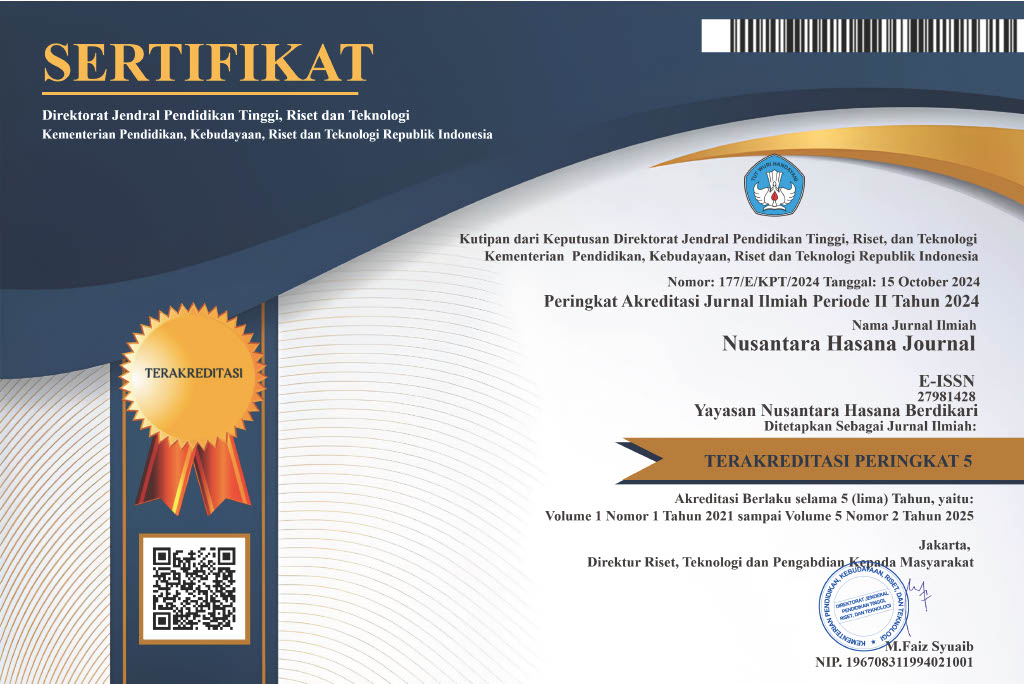STUDI PERENCANAAN DAN ESTIMASI BIAYA PADA TEBAL PERKERASAN KAKU DAN JALUR PEDESTRIAN
DOI:
https://doi.org/10.59003/nhj.v4i12.1453Keywords:
Pedestrian path, Road pavement, Sidewalk, TransportationAbstract
The western gate of ITERA. serves as one of the main access points for entering and exiting the campus, however, the pavement in this area has experienced structural deterioration, and pedestrian activities frequently occur on the roadway, posing safety concerns. This study aims to design the rigid pavement la.yer thickness and prepare a cost estima.tion (Bill of Quantities), as well as to plan a pedestrian walkwa.y a.t the western gate of ITERA. The design of the rigid pavement and pedestrian path was carried out using the 2024 Road Pavement Design Manual and the 2023 Technical Guidelines for Pedestrian Facility Planning. The proposed rigid pavement type is Jointed Plin Concrete Pavement (JPCP), consisting of a 150 mm thick concrete slab, a 100 mm thick lean concrete subbase, and a 150 mm thick Class A aggregate base layer. The longitudinal joints are designed using 13 mm dia.meter tie bars with a length of 600 mm and spaced at 750 mm intervals, while the tra.nsverse joints utilize 24 mm diameter dowel bars with a length of 450 mm, spaced at 300 mm intervals, and placed at every 4-meter distance. The total estimated cost for the pa.vement construction is RP 2,118,111,173.31. The pedestrian walkway is planned with a sidewalk width of 1.85 meters and a height of 20 centimeters.
Downloads
References
U. A.rif, M. Ja.vid, a.nd F. N. Kha.n, “Productivity Impacts of Infrastructure Development in Asia.,” Econ. Syst., vol. 45, no. 1, p. 100851, 2021, doi: 10.1016/j.ecosys.2020.100851.
R. Fernández, A.. Calvo, J. F. Correal, D. D’Ayala., and A.. L. Medaglia., “L.rge-scae School Building Infrastructure Improvement: the Case of ohe City of Cali, Colombia.,”
Socioecon. Plann. Sci., vol. 93, no. April, 2024, doi: 10.1016/j.seps.2024.101881.
E. Schnarre, S. Appiah-Opoku, J. Weber, a.nd S. Jones, “Improving Mobility and Infrastructura.l Connectivity on College Campus for Commuting Students: a. Case Study from the US,” Urban, Plan. Transp. Res., vol. 10, no. 1, pp. 466–482, Dec. 2022, doi: 10.1080/21650020.2022.2104755.
S. A.rzo a.nd M. Hong, “A. roadma.p to SDGs-emergence of technological innovation and infrastructure development for socia.l progress and mobility,” Environ. Res., vol. 246, p. 118102, 2024, doi: https://doi.org/10.1016/j.envres.2024.118102.
K. P. U. da.n P. R. D. J. B. Marga., Manual Desain Perkerasan Jalan 2024. Ja.ka.rta., 2024.
A.. Korochkin, “Impa.ct of Rigid Pa.vements with the Asphalt-Concrete Wea.ring Course on Roa.d Performa.nce a.nd Traffic Safety,” Transp Res. Procedia., vol. 36, pp. 315–319, 2018, doi: 10.1016/j.trpro.2018.12.091.
K. PUPR, “Pedoman Perencanaan Teknis Fasilitas Pejalan Kaki No. 18/SE/Db/2023,”
Kementeri. PUPR, no. 07, 2023.
Dokumen Lembaga Perencanaan dan Pengembangan ITERA., 2024
Downloads
Published
How to Cite
Issue
Section
License
Copyright (c) 2025 Putri Ayu Dwiyana

This work is licensed under a Creative Commons Attribution-NonCommercial-ShareAlike 4.0 International License.
NHJ is licensed under a Creative Commons Attribution-NonCommercial-ShareAlike 4.0 International License.
Articles in this journal are Open Access articles published under the Creative Commons CC BY-NC-SA License This license permits use, distribution and reproduction in any medium for non-commercial purposes only, provided the original work and source is properly cited.
Any derivative of the original must be distributed under the same license as the original.
























